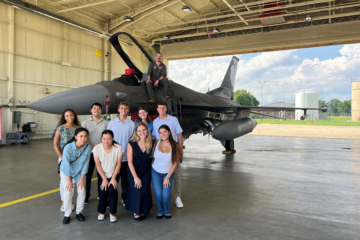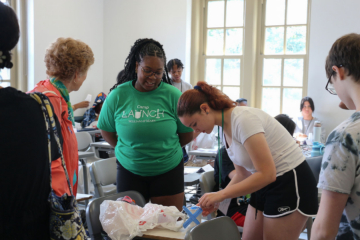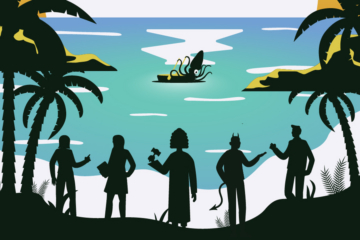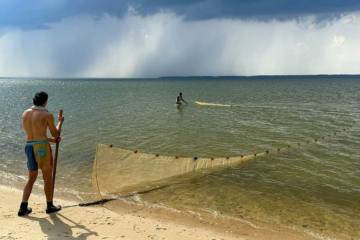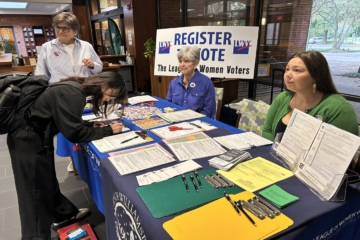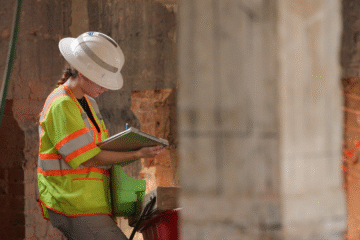The summer of cyber: W&M students gain real-world experience in cybersecurity
This wasn’t your typical game of capture the flag.
The version that Camden Good ’26 and Atticus Nafziger ’26 participated in this summer included a series of challenges involving cybersecurity knowledge and skills. In the end, the two William & Mary computer science majors placed in the top 10 out of all participants, including experts from the defense and private sectors.
“This gave me a lot of confidence that I actually belonged to this group of soldiers and professionals,” said Nafziger.
The game was part of Cyber Fortress, a two-week exercise hosted by the Virginia National Guard at the Virginia Beach State Military Reservation in August. Led by Computer Science Professor Matthew Chapman, Good and Nafziger were two of three William & Mary students to participate with a goal of helping make the nation’s cyber critical infrastructure safer.
“I gained some technical experience, but most importantly I learned valuable lessons in adapting to new software and situations,” said Good. “But even more so than that, I learned how to work well with an organized team towards a common goal.”
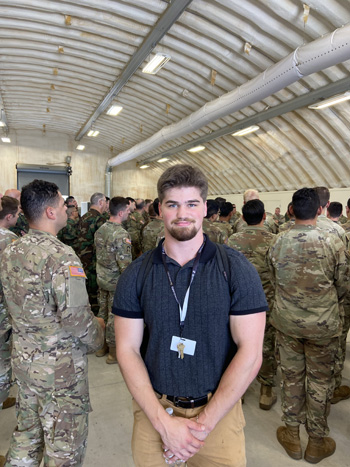
The event brought together federal, state and private sector partners to practice responding to and mitigating cyber threats against state and national infrastructure through simulated attacks, defensive responses and post-attack analysis.
This was the first year that William & Mary students have participated, reflecting the university’s growing reputation as a leader in the areas of computer science and national security. Careers and Data are among the core initiatives of William & Mary’s Vision 2026 strategic plan, and earlier this year, the university launched its School of Computing, Data Sciences & Physics.
Good said it was “absolutely incredible” that William & Mary is able to provide students opportunities like Cyber Fortress.
“I am so grateful and blessed that I was able to participate in such a high-level event, and I think that this is part of what makes William & Mary such an amazing organization,” he said. “The level to which they support their students is wonderful.”
Building a Cyber Fortress
Together with the participating agencies, the William & Mary students who participated in Cyber Fortress engaged in firsthand learning of how to safeguard the area’s utilities and build collective partnerships to enhance cybersecurity measures.
During the first week, participants took a variety of classes on a wide range of different cybersecurity fields and skills, and during the second week, they engaged in simulated cyber exercises as teams.
Good said the most challenging part was learning how to use new systems and software on the fly during week two.
“This is generally a strength of mine, but it was still very difficult especially considering the complexity of the task at hand,” he said. “The most rewarding part was being able to help my team learn the software as well, given that I was able to gain understanding of the uses first.”
Chapman said the exercise provided great exposure for the students in working with federal, state and industry partners in cybersecurity. He said his students rose to the challenge, with Good earning a Department of the Army Certificate of Achievement and capturing fifth place overall in the exercise’s cyber capture-the-flag competition.
“Their technical skills and ability to integrate into seasoned cyber teams certainly raised a few eyebrows,” stated Chapman. “I can confidently tell you that these William & Mary students are poised to be national and global leaders in cybersecurity, in a time when cybersecurity considerations of national critical infrastructure are at their highest in history.”
Nafziger, who penned a reflection on the experience, said that it solidified his interest in pursuing a cybersecurity career. For other students who may get the opportunity to participate in the future, Nafziger says, “Go for it!”
“Cyber Fortress is an amazing opportunity to rapidly develop your skills, find gaps in your knowledge and build your network,” he said.
Good concurred.
“I would say that this experience, more than any other I have had so far in my career, gave me real-world experience on how to work in a team and how workflow in the actual industry works,” he said. “If you are looking for experience that employers want to see, it is perfect.”
Serving through cyber education
While Cyber Fortress made a significant impact on its participants, the summer contributions of William & Mary to the nation’s cyber capabilities extended far beyond it.
In May, William & Mary joined the U.S. Department of Defense’s VICEROY Scholars Program as its 14th Virtual Institute, along with West Virginia University and Marshall University. Administered by the Griffiss Institute, Virtual Institutes for Cyber and Electromagnetic Spectrum Research and Employ (VICEROY) creates a vital linkage between U.S. cyber operators and academia to grow future military and civilian leaders through curriculum, exercises and simulations, student organizations and internship experiences.
Supported by the Whole of Government Center of Excellence, the first cohort of William & Mary VICEROY Scholars completed their cyber internships at the U.S. Air Force’s Air Combat Command in Hampton, Virginia, from June until August, with nine students coming in from the mathematics, computer science and data science departments. Students received funding from VICEROY and were granted security clearances to complete their work.
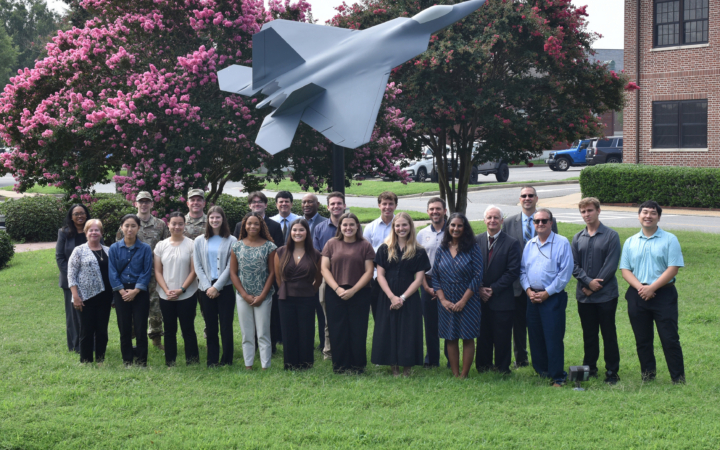
During her internship, Kathryn Hamilton ’25, M.S. ’29, a master’s student in computer science, tackled issues around the detection and tracking of small Unmanned Aerial Systems, according to an Air Combat Command news story. Another W&M computer science major, Brian Ding ’26, developed automated data pipelines that convert and store real-time weather and drone data, integrating it with the Air Force’s testing tools.
An additional two students participated in cyber internships at Air Combat Command under the Whole of Government Center of Excellence National Security Internship Program (NSIP) and were supervised by Mansfield Professor of Business Chon Abraham.
Both VICEROY and NSIP opportunities at Air Combat Command are part of an Educational Partnership Agreement signed by W&M Provost Peggy Agouris; Brigadier General Jason Bartolomei, technology executive officer for the Department of the Air Force; and John Matyjas, chief scientist for Air Combat Command, in January 2025 to encourage and enhance science, mathematics and engineering educational and research collaborations between the Air Force major combat command and William & Mary.
As the university prepared for the start of the academic year, the Reves Center for International Studies, Military & Veteran Affairs Team and Whole of Government Center of Excellence hosted a visiting delegation from the Virginia National Guard, Finnish Air Force and Jamk University of Applied Sciences to discuss ways Virginia, William & Mary and Finland could work together more closely on faculty and student cyber collaborations to make the digital landscape safer and more secure against threats. Jamk University hosted a special demonstration of its cyber range for William & Mary faculty, staff and students in September. That same month, three William & Mary students attended a STEM day demonstration at the Bold Quest exercise in Blackstone, Virginia.
This past academic year also saw William & Mary’s acceptance in the U.S. Space Command’s Academic Engagement Enterprise and designation as a National Center of Academic Excellence in Cybersecurity Research by the National Security Agency. William & Mary also has a new partnership Memorandum of Understanding (MOU) with the Virginia Air National Guard and is pursuing joint activities in the cyber realm.
“As a public university, William & Mary welcomes the chance to partner with senior military commands. We have a strong public service culture and incredibly talented students who are ready to lean into and help solve the most pressing global challenges,” said Kathleen T. Jabs, special assistant to the president for military & veteran affairs.
These opportunities are especially supported by William & Mary’s Military & Veteran Affairs Team, Whole of Government Center of Excellence, funds from the National Security Internship Program and corresponding academic departments. For more information, please contact wgc@wm.edu.
“William & Mary is taking applied learning to the next level, where students guided by our teams make real contributions to our democracy in the field,” said Kathryn H. Floyd, director of the Whole of Government Center of Excellence. “Engagement with cyber defense is not just about sitting at a computer. These opportunities give students the knowledge and skills to be leaders in the future of national security.”
Latest W&M News
- Coping with a painful childhoodInternational study shows college students who experienced family dysfunction as children sometimes turn to alcohol to cope with the long-term impacts.
- W&M’s Center for Gifted Education expands pre-collegiate summer campsOfferings strengthen access and year-round support for Virginia students.
- Raft Debate 2025: Who will keep their spot on the raft?The beloved W&M tradition returns Oct. 28 starting at 6 p.m. in the Sadler Center’s Commonwealth Auditorium.
- An average year for juvenile striped bass in Virginia waters in 2025Preliminary results from an ongoing long-term survey suggest that an average year class of young-of-year striped bass was produced in the Virginia tributaries of the Chesapeake Bay in 2025.
- Helping students fulfill their civic dutyAs part of its commitment to democracy, W&M is dedicated to helping students, faculty and staff participate in elections.
- Uncovering layers of historyAs part of the team uncovering the foundations of the historic Williamsburg Bray School, Heather Little M.A. ’23 and Madeline Dorton ’24 are unearthing the history of the campus where they studied history and archaeology as students.



